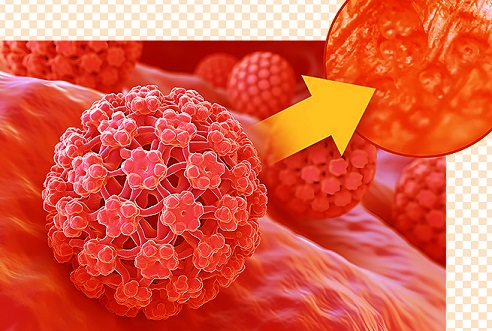Scientists From Finland Discover That HPV16 E6 Protein Plays a Role in Breast Cancer
Nikhil Prasad Fact checked by:Thailand Medical News Team Dec 11, 2024 4 months, 2 days, 40 minutes ago
Medical News: Breast cancer remains one of the most prevalent cancers affecting women globally, with over 2.3 million cases reported in 2020 alone. While significant strides have been made in treatment, including chemotherapy, radiation, and targeted therapies, a substantial percentage of patients with early-stage breast cancer still face relapses. Scientists continuously explore factors influencing breast cancer’s development and progression. One emerging area of interest is the possible role of human papillomavirus (HPV) in breast cancer biology.
 Scientists From Finland Discover That HPV16 E6 Protein Plays a Role in Breast Cancer
Scientists From Finland Discover That HPV16 E6 Protein Plays a Role in Breast Cancer
HPV, primarily linked to cervical and other cancers, has over 200 known types, with high-risk strains such as HPV16 and HPV18 recognized for their role in oncogenesis. This
Medical News report focuses on recent findings regarding how the HPV16 E6 protein affects breast cancer cells. Researchers from the University of Oulu and other institutions in Finland investigated whether HPV16 E6 influences Toll-like receptor 9 (TLR9) expression, a molecule linked to cancer prognosis and immune responses.
What is Toll-like Receptor 9?
TLR9 is a receptor found in many cell types, including immune and cancer cells. It plays a vital role in recognizing viral and bacterial DNA, triggering immune responses. Intriguingly, TLR9 also influences cellular processes like proliferation and autophagy - key mechanisms that cancer cells can hijack for survival and growth. Studies have shown that low TLR9 expression correlates with poor outcomes in triple-negative breast cancer (TNBC), an aggressive breast cancer subtype. However, the exact role of TLR9 in breast cancer remains poorly understood.
HPV has been shown to interfere with TLR9 function in cervical and head-and-neck cancers. The current study aimed to determine whether similar effects occur in breast cancer.
Study Approach and Key Methods
The research team designed a series of experiments to test their hypothesis. Breast cancer cell lines, including the TNBC cell line MDA-MB-231 and estrogen receptor-positive (ER+) T-47D cells, were exposed to lentiviruses engineered to express the HPV16 E6 protein. By analyzing TLR9 expression and cellular behavior under normoxic and hypoxic conditions, researchers hoped to shed light on the relationship between HPV16 E6 and breast cancer. Additionally, clinical breast cancer tissue samples from 37 patients were examined for the presence of HPV DNA.
Findings on TLR9 Expression
The study uncovered that HPV16 E6 expression significantly suppressed TLR9 messenger RNA (mRNA) levels in both MDA-MB-231 and T-47D cells under hypoxic conditions. Hypoxia, often present in tumor microenvironments, is known to regulate TLR9 levels. However, the E6 protein’s effects on TLR9 expression did not translate to notable changes at the protein level, suggesting a complex regulation mechanism. This suppression of TLR9 transcripts highlights a potential pathway by which HPV16 E6 could influence breast canc
er cell biology.
Altered Proliferation in Breast Cancer Cells
The HPV16 E6 protein showed contrasting effects on the proliferation of the two cell lines studied. In MDA-MB-231 cells, which lack estrogen receptors, E6 expression significantly increased proliferation. In contrast, in ER+ T-47D cells, the protein reduced proliferation rates. This dual effect hints at the role of estrogen signaling in mediating E6’s impact. Previous research has suggested that estrogen can modulate HPV16’s viral proteins and alter cell survival, potentially explaining these differences.
Effects on Migration and Invasion
Despite influencing proliferation, E6 expression did not significantly impact the migratory or invasive abilities of either cell line. Using a scratch wound model, researchers found that HPV16 E6 did not alter wound closure rates, even when cells were embedded in a protein-rich matrix. This finding contrasts with prior studies in other cancers, where HPV was linked to enhanced invasion and metastasis.
Reduced Chemotherapy Sensitivity
One of the most striking findings was how HPV16 E6 affected chemotherapy responses. Breast cancer cells expressing the E6 protein showed reduced sensitivity to standard chemotherapeutic agents such as cyclophosphamide, docetaxel, and doxorubicin. This effect was particularly pronounced in ER+ T-47D cells but was also observed in MDA-MB-231 cells treated with cyclophosphamide. This suggests that HPV16 E6 could impair the effectiveness of chemotherapy in breast cancer, a discovery that warrants further investigation.
HPV Detection in Breast Cancer Tissues
The research team also sought to detect HPV DNA in breast cancer specimens from 37 patients. Using sensitive PCR methods capable of identifying multiple HPV strains, they found no evidence of HPV DNA in these samples. This result aligns with some previous studies but contradicts others that have reported HPV presence in breast cancer tissues. Differences in detection methods and sample populations may account for these discrepancies. The researchers emphasized the need for larger studies to definitively determine HPV’s presence in breast cancer.
Conclusions and Implications
This study’s findings provide new insights into how HPV16 E6 could influence breast cancer biology, even in the absence of detectable viral DNA in clinical samples. The ability of HPV16 E6 to suppress TLR9 mRNA, alter proliferation, and reduce chemotherapy sensitivity highlights its potential role in shaping breast cancer outcomes. These results suggest that HPV16 E6 might act as a modifier of breast cancer behavior rather than a direct cause.
Understanding the interaction between HPV and breast cancer could open new avenues for personalized treatment approaches. For instance, targeting HPV-associated pathways might improve chemotherapy responses in HPV-infected cancers. However, these findings also raise questions about how common HPV infections affect treatment outcomes across various cancers, including those traditionally considered HPV-negative.
The study findings were published in the peer-reviewed journal: Molecular Biology Reports.
https://link.springer.com/article/10.1007/s11033-024-10143-1
For the latest on Breast Cancer, keep on logging to Thailand
Medical News.
Read Also:
https://www.thailandmedical.news/news/turkish-study-explores-possible-link-between-microbiota-and-breast-cancer
https://www.thailandmedical.news/news/breast-cancer-research-highlights-the-biphasic-effects-of-red-clover-extracts
https://www.thailandmedical.news/news/breast-cancer-rates-rising-among-younger-women
